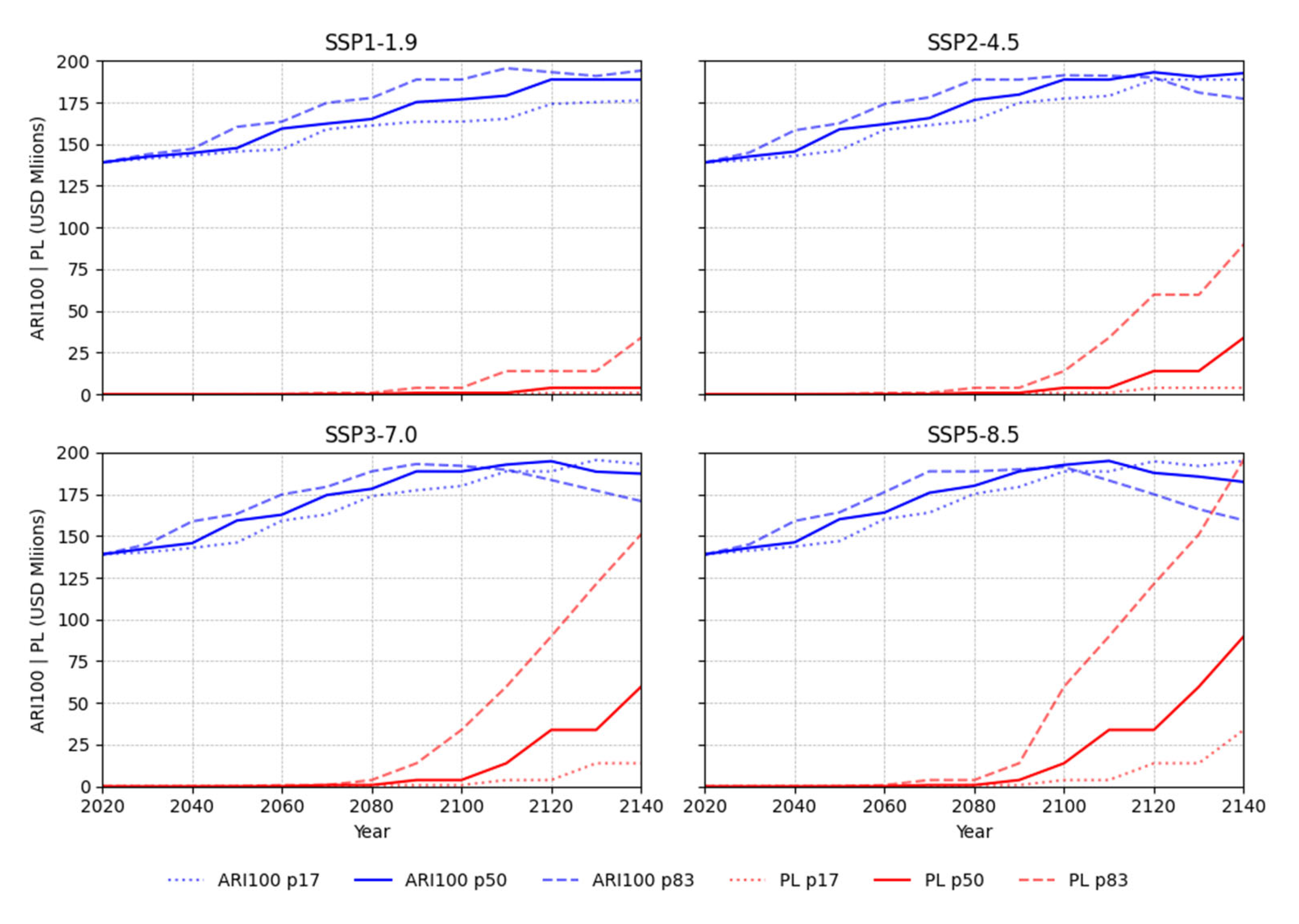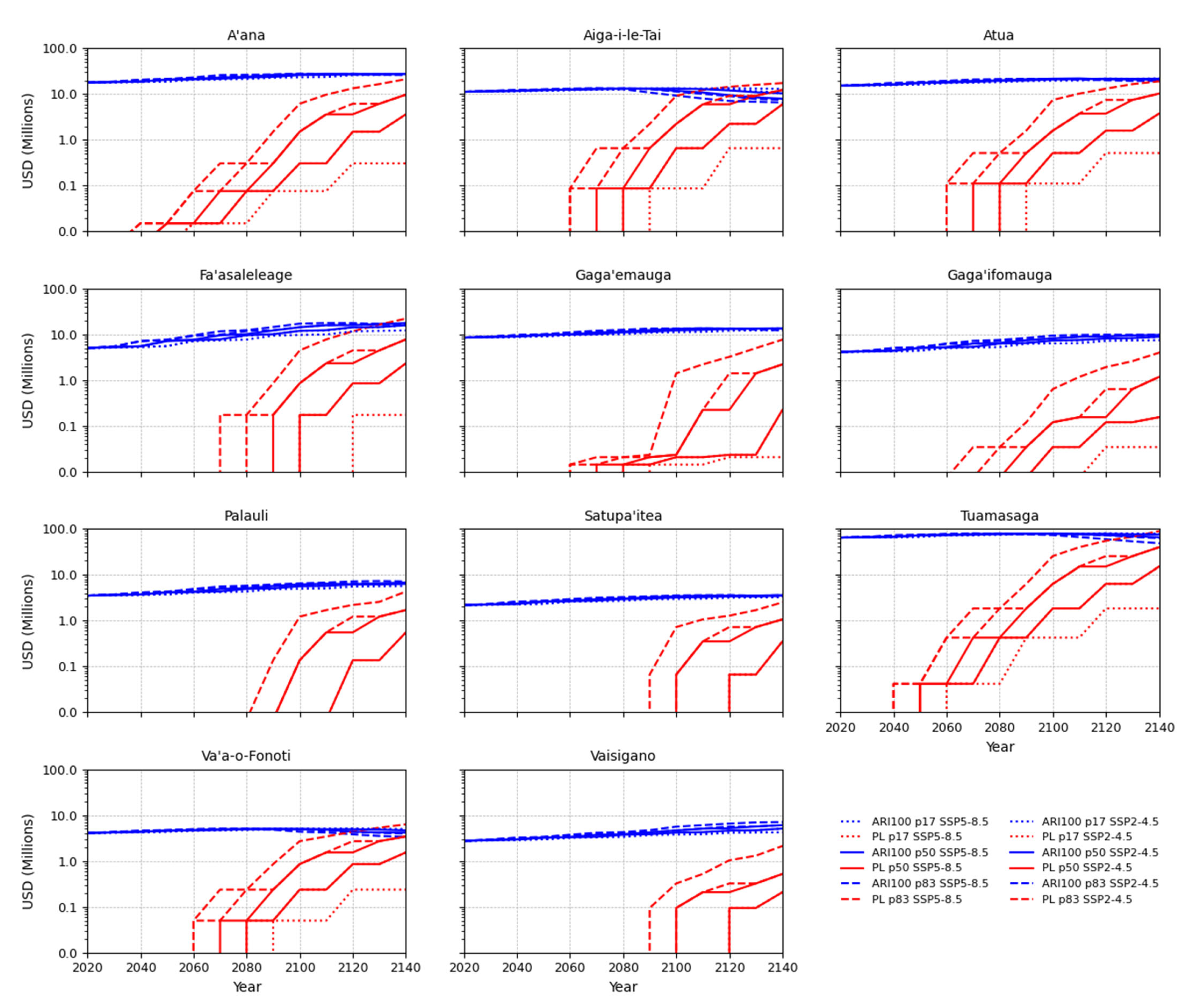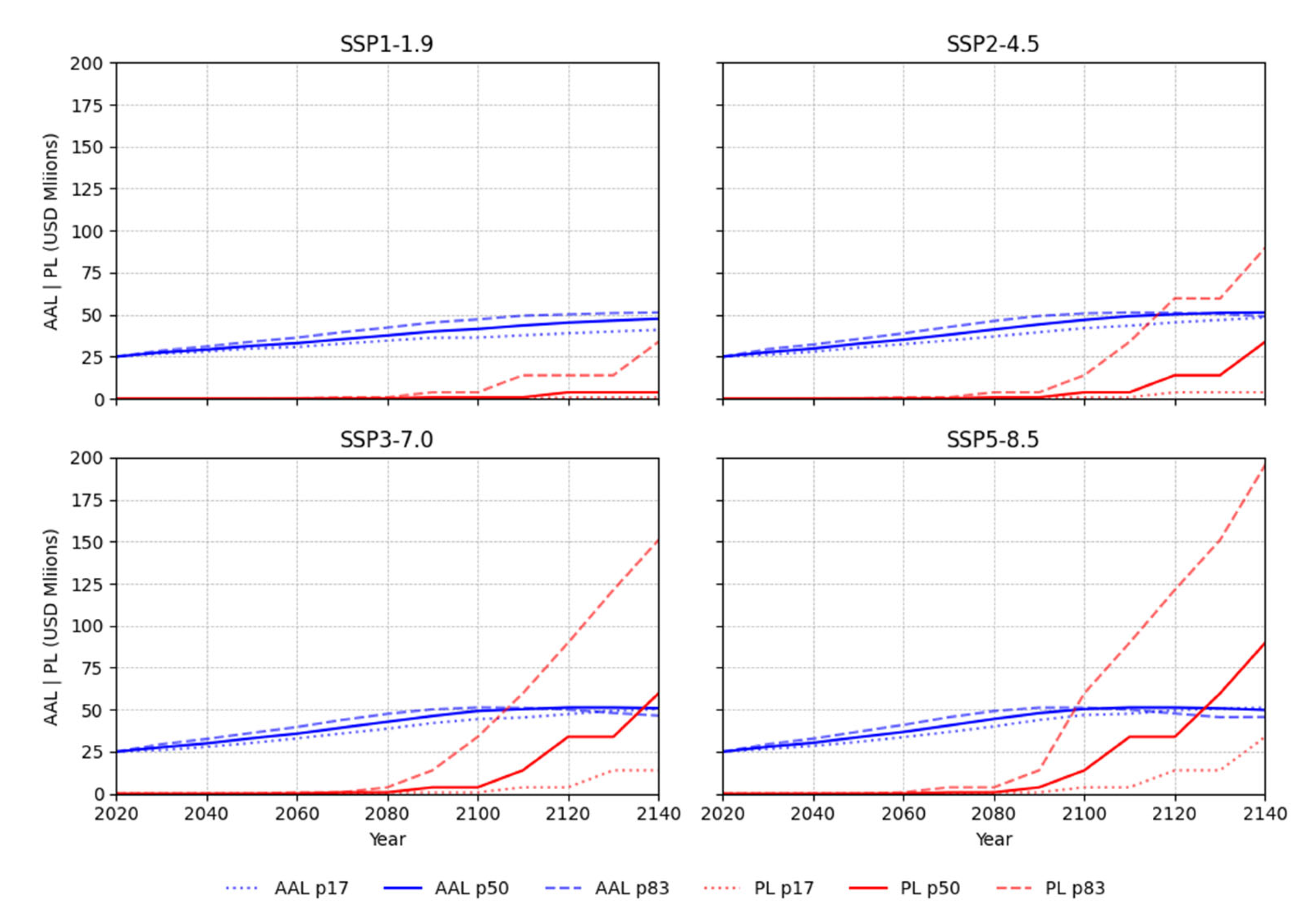Evaluation of Extreme Sea Level Flooding Risk to Buildings in Samoa
Abstract
1. Introduction
2. Materials and Methods
2.1. Input Data
2.1.1. Hazard
2.1.2. Exposure
2.1.3. Vulnerability
2.2. Geoprocessing and Sampling
2.3. Risk Analysis
3. Results and Discussion
3.1. Building Economic Losses from 100-Year Annual Recurrence Interval Coastal Flooding
3.2. Average Annual Losses from Coastal Flooding
3.3. Study Limitations
4. Conclusions
Author Contributions
Funding
Data Availability Statement
Acknowledgments
Conflicts of Interest
References
- Nurse, L.A.; McLean, R.F.; Agard, J.; Briguglio, L.P.; Duvat-Magnan, V.; Pelesikoti, N.; Tompkins, E.; Webb, A. Small islands. In Climate Change 2014: Impacts, Adaptation, and Vulnerability. Part B: Regional Aspects. Contribution of Working Group II to the Fifth Assessment Report of the Intergovernmental Panel on Climate Change; Cambridge University Press: Cambridge, UK, 2014; p. 1613. [Google Scholar]
- Betzold, C. Adapting to climate change in small island developing states. Clim. Change 2015, 133, 481–489. [Google Scholar] [CrossRef]
- Scott, G. Climate Change and Displacement in the Pacific: An Overview; UNHCR: Geneva, Switzerland, 2019. [Google Scholar]
- Vitousek, S.; Barnard, P.L.; Fletcher, C.H.; Frazer, N.; Erikson, L.; Storlazzi, C.D. Doubling of coastal flooding fre-quency within decades due to sea-level rise. Sci. Rep. 2017, 7, 1399. [Google Scholar] [CrossRef]
- Hauer, M.E.; Fussell, E.; Mueller, V.; Burkett, M.; Call, M.; Abel, K.; McLeman, R.; Wrathall, D. Sea-level rise and human migration. Nat. Rev. Earth Environ. 2020, 1, 28–39. [Google Scholar] [CrossRef]
- Levy, R.; Naish, T.; Lowry, D.; Priestley, R.; Winefield, R.; Alevropolous-Borrill, A.; Beck, E.; Bell, R.; Blick, G.; Dadic, R.; et al. Melting ice and rising seas–connecting projected change in Antarctica’s ice sheets to communities in Aotearoa New Zealand. J. R. Soc. N. Z. 2024, 54, 449–472. [Google Scholar] [CrossRef] [PubMed]
- Breili, K.; Simpson, M.J.R.; Klokkervold, E.; Roaldsdotter Ravndal, O. High-accuracy coastal flood mapping for Norway using lidar data. Nat. Hazards Earth Syst. Sci. 2020, 20, 673–694. [Google Scholar] [CrossRef]
- Paulik, R.; Stephens, S.A.; Bell, R.G.; Wadhwa, S.; Popovich, B. National-scale built-environment exposure to 100-year extreme sea levels and sea-level rise. Sustainability 2020, 12, 1513. [Google Scholar] [CrossRef]
- Bates, P.D.; Quinn, N.; Sampson, C.; Smith, A.; Wing, O.; Sosa, J.; Savage, J.; Olcese, G.; Neal, J.; Schumann, G.; et al. Combined modeling of US fluvial, pluvial, and coastal flood hazard under current and future climates. Water Resour. Res. 2021, 57, e2020WR028673. [Google Scholar] [CrossRef]
- Wandres, M.; Espejo, A.; Sovea, T.; Tetoa, S.; Malologa, F.; Webb, A.; Lewis, J.; Lee, G.; Damlamian, H. A national-scale coastal flood hazard assessment for the atoll nation of Tuvalu. Earth’s Future 2024, 12, e2023EF003924. [Google Scholar] [CrossRef]
- Lin, S.L.; Ungaro, J.; Nimau, J.T.; Singh, S.; Raqisia, K. Development of pacific exposure dataset for use in catastrophe risk assessment. Nat. Hazards 2020, 104, 2645–2661. [Google Scholar] [CrossRef]
- Paulik, R.; Horspool, N.; Woods, R.; Griffiths, N.; Beale, T.; Magill, C.; Wild, A.; Popovich, B.; Walbran, G.; Garlick, R. RiskScape: A flexible multi-hazard risk modelling engine. Nat. Hazards 2023, 119, 1073–1090. [Google Scholar] [CrossRef]
- Merrifield, M.A.; Becker, J.M.; Ford, M.; Yao, Y. Observations and estimates of wave-driven water level extremes at the Marshall Islands. Geophys. Res. Lett. 2014, 41, 7245–7253. [Google Scholar] [CrossRef]
- Hersbach, H.; Bell, B.; Berrisford, P.; Hirahara, S.; Horányi, A.; Muñoz-Sabater, J.; Nicolas, J.; Peubey, C.; Radu, R.; Schepers, D.; et al. The ERA5 global reanalysis. Q. J. R. Meteorol. Soc. 2020, 146, 1999–2049. [Google Scholar] [CrossRef]
- Zuo, H.; Balmaseda, M.A.; Tietsche, S.; Mogensen, K.; Mayer, M. The ECMWF operational ensemble reanalysis–analysis system for ocean and sea ice: A description of the system and assessment. Ocean Sci. 2019, 15, 779–808. [Google Scholar] [CrossRef]
- Egbert, G.D.; Erofeeva, S.Y. Efficient inverse modeling of barotropic ocean tides. J. Atmos. Ocean. Technol. 2002, 19, 183–204. [Google Scholar] [CrossRef]
- Joyce, B.R.; Gonzalez-Lopez, J.; Van der Westhuysen, A.J.; Yang, D.; Pringle, W.J.; Westerink, J.J.; Cox, A.T. U.S. IOOS coastal and ocean modeling testbed: Hurricane-induced winds, waves, and surge for deep ocean, reef-fringed islands in the Caribbean. J. Geophys. Res. Ocean. 2019, 124, 2876–2907. [Google Scholar] [CrossRef]
- Tu’uholoaki, M.; Espejo, A.; Wandres, M.; Singh, A.; Damlamian, H.; Begg, Z. Quantifying mechanisms responsible for extreme coastal water levels and flooding during severe tropical cyclone Harold in Tonga, southwest Pacific. J. Mar. Sci. Eng. 2023, 11, 1217. [Google Scholar] [CrossRef]
- Espejo, A.; Wandres, M.; Damlamian, H.; Divesh, A.; Giblin, J.; Aucan, J.; Eria, M.; Toorua, U. Efficient coastal inundation early-warning system for low-lying atolls, dealing with lagoon and ocean side inundation in Tarawa, Kiribati. Weather Clim. Extrem. 2023, 42, 100615. [Google Scholar] [CrossRef]
- Stephens, S.A.; Paulik, R.; Reeve, G.; Wadhwa, S.; Popovich, B.; Shand, T.; Haughey, R. Future changes in built environment risk to coastal flooding, permanent inundation and coastal erosion hazards. J. Mar. Sci. Eng. 2021, 9, 1011. [Google Scholar] [CrossRef]
- FUGRO. Report of Survey: Airborne Lidar Bathymetric and Topographic Survey of Samoa 2015; Contract: ECRCR-LIB 2.1, Fugro LADS Document Reference No: TLCS00.047.008, Issue No: 1.00; Fugro LADS Corporation Pty Ltd.: Kidman Park, Australia, 2016. [Google Scholar]
- Bosserelle, C.; Williams, S.; Cheung, K.F.; Lay, T.; Yamazaki, Y.; Simi, T.; Roeber, V.; Lane, E.; Paulik, R.; Simanu, L. Effects of source faulting and fringing reefs on the 2009 South Pacific Tsunami inundation in southeast Upolu, Samoa. J. Geophys. Res. Ocean. 2020, 125, e2020JC016537. [Google Scholar] [CrossRef]
- Fox-Kemper, B. Ocean, cryosphere and sea level change. In Climate Change 2021: The Physical Science Basis. Contribution of Working Group I to the Sixth Assessment Report of the Intergovernmental Panel on Climate Change; Cambridge University Press: Cambridge, UK, 2021; pp. 1211–1362. [Google Scholar]
- Paulik, R.; Wild, A.; Stephens, S.; Welsh, R.; Wadhwa, S. National assessment of extreme sea-level driven inundation under rising sea levels. Front. Environ. Sci. 2023, 10, 1045743. [Google Scholar] [CrossRef]
- Pacific Regional Infrastructure Facility (PRIF). Methodology for Condition Assessment of Public Sector Infrastructure Assets in Pacific Island Countries. 2021. Available online: https://www.theprif.org/document/regional/infrastructure-maintenance/methodology-for-condition-assessment-public-sector (accessed on 12 May 2025).
- Williams, S.; Paulik, R.; Weaving, R.; Bosserelle, C.; Chan Ting, J.; Wall, K.; Simi, T.; Scheele, F. Multiscale quantification of tsunami hazard exposure in a pacific small island developing state: The case of Samoa. GeoHazards 2021, 2, 63–79. [Google Scholar] [CrossRef]
- Paulik, R.; Williams, S.; Simi, T.; Bosserelle, C.; Ting, J.C.; Simanu, L. Evaluating building exposure and economic loss changes after the 2009 South Pacific Tsunami. Int. J. Disaster Risk Reduct. 2021, 56, 102131. [Google Scholar] [CrossRef]
- Sischka, L.; Bosserelle, C.; Williams, S.; Ting, J.C.; Paulik, R.; Whitworth, M.; Talia, L.; Viskovic, P. Reconstructing the 26 June 1917 Samoa tsunami disaster. Appl. Sci. 2022, 12, 3389. [Google Scholar] [CrossRef]
- Welsh, R.; Williams, S.; Bosserelle, C.; Paulik, R.; Chan Ting, J.; Wild, A.; Talia, L. Sea-level rise effects on changing hazard exposure to far-field tsunamis in a volcanic Pacific island. J. Mar. Sci. Eng. 2023, 11, 945. [Google Scholar] [CrossRef]
- Pacific Risk Information System. ‘Data: Layers.’ Suva, Fiji. Pacific Community (SPC). 2023. Available online: https://geonode.pacificdata.org (accessed on 25 November 2023).
- Chen, T.; Guestrin, C. August. Xgboost: A scalable tree boosting system. In Proceedings of the 22nd ACM SIGKDD International Conference on Knowledge Discovery and Data Mining, San Francisco, CA, USA, 13–17 August 2016; pp. 785–794. [Google Scholar]
- Paulik, R.; Chang-Ting, J.; Williams, S. Flood damage evaluation for buildings in a small island developing state. Water Resour. Res. 2025, 61, e2025WR040141. [Google Scholar] [CrossRef]
- Nirandjan, S.; Koks, E.E.; Ye, M.; Pant, R.; Van Ginkel, K.C.; Aerts, J.C.; Ward, P.J. Physical vulnerability database for critical infrastructure hazard risk assessments-a systematic review and data collection. Nat. Hazards Earth Syst. Sci. 2024, 24, 4341–4368. [Google Scholar] [CrossRef]
- Lan, C.; Wild, A.; Paulik, R.; Wotherspoon, L.; Zorn, C. Assessing indirect impacts of extreme sea level flooding on critical infrastructure. J. Mar. Sci. Eng. 2023, 11, 1420. [Google Scholar] [CrossRef]
- Haer, T.; Botzen, W.W.; de Moel, H.; Aerts, J.C. Integrating household risk mitigation behavior in flood risk analysis: An agent-based model approach. Risk Anal. 2017, 37, 1977–1992. [Google Scholar] [CrossRef]
- Logan, T.M.; Anderson, M.J.; Reilly, A.C. Risk of isolation increases the expected burden from sea-level rise. Nat. Clim. Change 2023, 13, 397–402. [Google Scholar] [CrossRef]
- Chen, X.; Zhang, H.; Chen, W.; Huang, G. Urbanization and climate change impacts on future flood risk in the Pearl River Delta under shared socioeconomic pathways. Sci. Total Environ. 2021, 762, 143144. [Google Scholar] [CrossRef]
- Barnard, P.L.; Erikson, L.H.; Foxgrover, A.C.; Hart, J.A.F.; Limber, P.; O’Neill, A.C.; Van Ormondt, M.; Vitousek, S.; Wood, N.; Hayden, M.K.; et al. Dynamic flood modeling essential to assess the coastal impacts of climate change. Sci. Rep. 2019, 9, 4309. [Google Scholar] [CrossRef]







| Attributes | Attribute Classes or Description | Data Type * | |
|---|---|---|---|
| Location | District | A’ana; Aiga-i-le-Tai; Atua; Fa’asaleleage; Gaga’emauga; Gaga’ifomauga; Palauli; Satupa’itea; Tuamasaga; Va’a-o-Fonoti; Vaisigano | Text (N) |
| Geometric | Area | Building roof outline area (m2) | Integer (C) |
| Stories | Number of complete building floor levels | Integer (C) | |
| Non-geometric | Primary Use | Residential (House; Fale); Commercial (Retail; Accommodation); Government (Public services; Education); Health (Clinic; Hospital) Community; Religious; Industrial (Manufacturing; Storage), Infrastructure Utility; Accommodation; Out building; Other | Text (N) |
| Replacement Value | Building replacement value estimated in 2020 US dollars (USD) | Integer (C) | |
| Structural Frame | Concrete (Concrete column, Tilt-Up Slab, and Load bearing wall); Steel (Steel column; Steel frame); Timber (Timber frame; Wooden pole); Other | Text (N) | |
| Wall Cladding | Concrete Masonry; Fiber-cement; Metal sheet; Open; Other; Mixed; Timber; Traditional | Text (N) | |
Disclaimer/Publisher’s Note: The statements, opinions and data contained in all publications are solely those of the individual author(s) and contributor(s) and not of MDPI and/or the editor(s). MDPI and/or the editor(s) disclaim responsibility for any injury to people or property resulting from any ideas, methods, instructions or products referred to in the content. |
© 2025 by the authors. Licensee MDPI, Basel, Switzerland. This article is an open access article distributed under the terms and conditions of the Creative Commons Attribution (CC BY) license (https://creativecommons.org/licenses/by/4.0/).
Share and Cite
Paulik, R.; Williams, S.; Chan-Ting, J.; Bosserelle, C.; Espejo, A.; Wandres, M.; Pogi, K.; Vaimagalo, S.; Pearson, R.; Giblin, J.; et al. Evaluation of Extreme Sea Level Flooding Risk to Buildings in Samoa. J. Mar. Sci. Eng. 2025, 13, 2143. https://doi.org/10.3390/jmse13112143
Paulik R, Williams S, Chan-Ting J, Bosserelle C, Espejo A, Wandres M, Pogi K, Vaimagalo S, Pearson R, Giblin J, et al. Evaluation of Extreme Sea Level Flooding Risk to Buildings in Samoa. Journal of Marine Science and Engineering. 2025; 13(11):2143. https://doi.org/10.3390/jmse13112143
Chicago/Turabian StylePaulik, Ryan, Shaun Williams, Josephina Chan-Ting, Cyprien Bosserelle, Antonio Espejo, Moritz Wandres, Katie Pogi, Sujina Vaimagalo, Rose Pearson, Judith Giblin, and et al. 2025. "Evaluation of Extreme Sea Level Flooding Risk to Buildings in Samoa" Journal of Marine Science and Engineering 13, no. 11: 2143. https://doi.org/10.3390/jmse13112143
APA StylePaulik, R., Williams, S., Chan-Ting, J., Bosserelle, C., Espejo, A., Wandres, M., Pogi, K., Vaimagalo, S., Pearson, R., Giblin, J., Hosse, L., Battersby, J., Ungaro, J., Damlamian, H., & Naivalurua, O. (2025). Evaluation of Extreme Sea Level Flooding Risk to Buildings in Samoa. Journal of Marine Science and Engineering, 13(11), 2143. https://doi.org/10.3390/jmse13112143







